Continuous Improvement Plan for Latino Engineering Project Management
VerifiedAdded on 2020/03/16
|12
|3746
|33
Report
AI Summary
This report presents a comprehensive analysis of a project management case study focused on Latino Engineering Pvt. Ltd., a company experiencing declining performance due to issues with equipment quality, customer communication, and after-sales service. The report identifies the root causes of these problems through analysis of the company's working structure and proposes a continuous improvement plan. The plan emphasizes the importance of root cause analysis tools, risk mitigation strategies, and the implementation of the PLAN-DO-CHECK-ACT cycle. Key areas of focus include improving equipment design, employee training, and raw material quality control. The report recommends strategies such as customer perspective analysis, democratic leadership, and the use of Key Performance Indicators (KPIs) to enhance the company's productivity, profitability, and long-term sustainability by improving equipment quality and customer satisfaction. The report emphasizes that this analysis and solution are available to help students on Desklib.
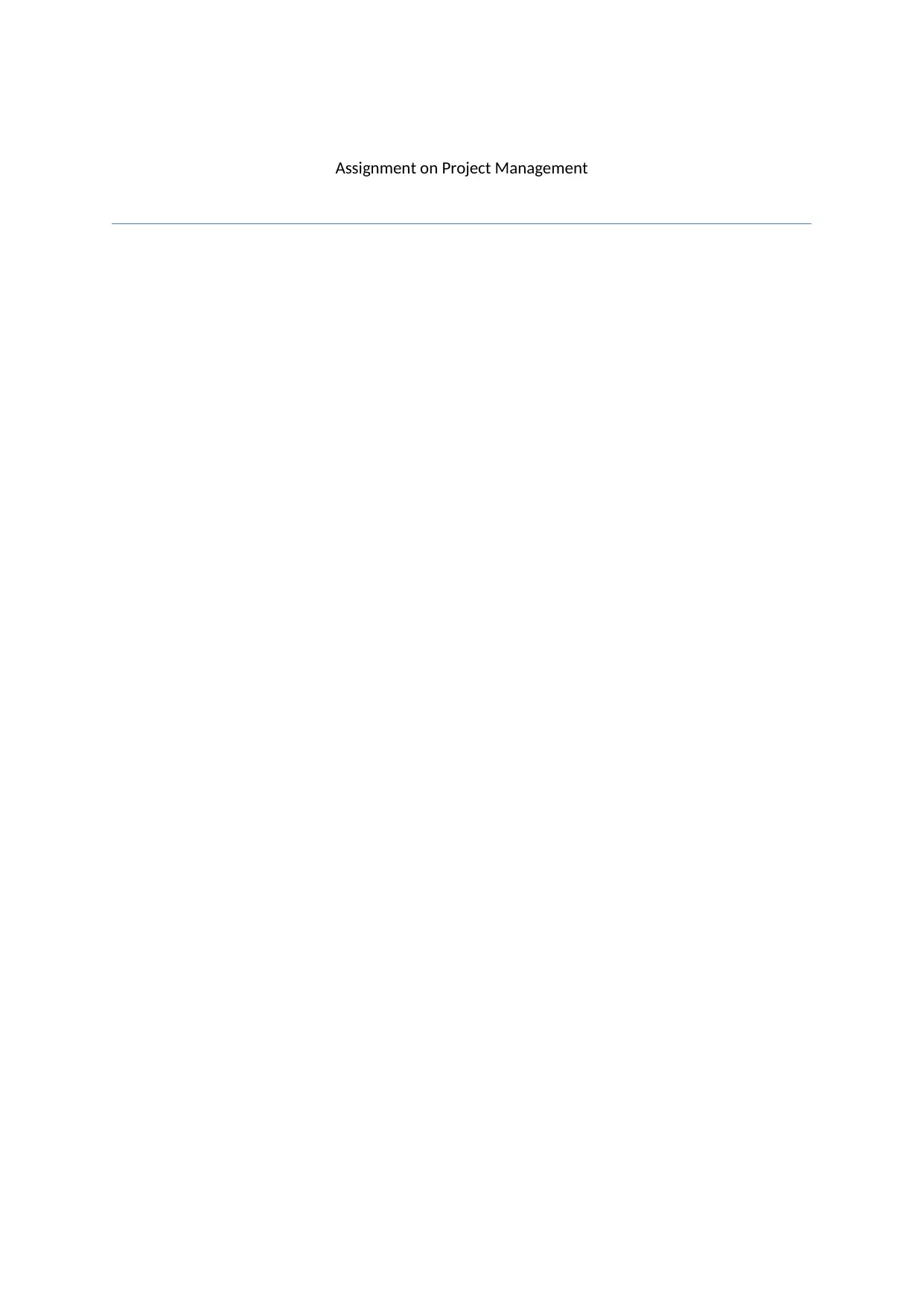
Assignment on Project Management
Paraphrase This Document
Need a fresh take? Get an instant paraphrase of this document with our AI Paraphraser
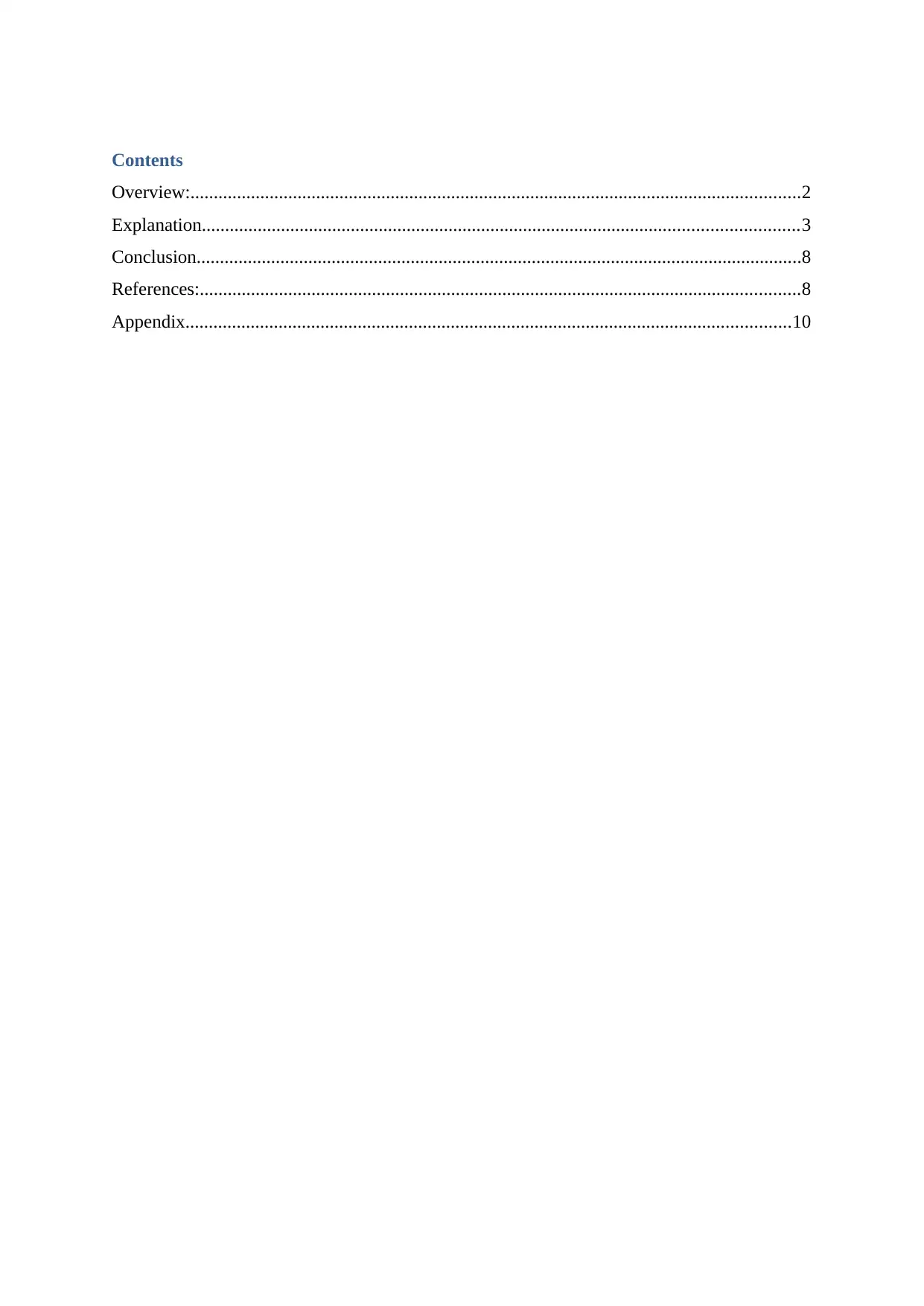
Contents
Overview:...................................................................................................................................2
Explanation................................................................................................................................3
Conclusion..................................................................................................................................8
References:.................................................................................................................................8
Appendix..................................................................................................................................10
Overview:...................................................................................................................................2
Explanation................................................................................................................................3
Conclusion..................................................................................................................................8
References:.................................................................................................................................8
Appendix..................................................................................................................................10
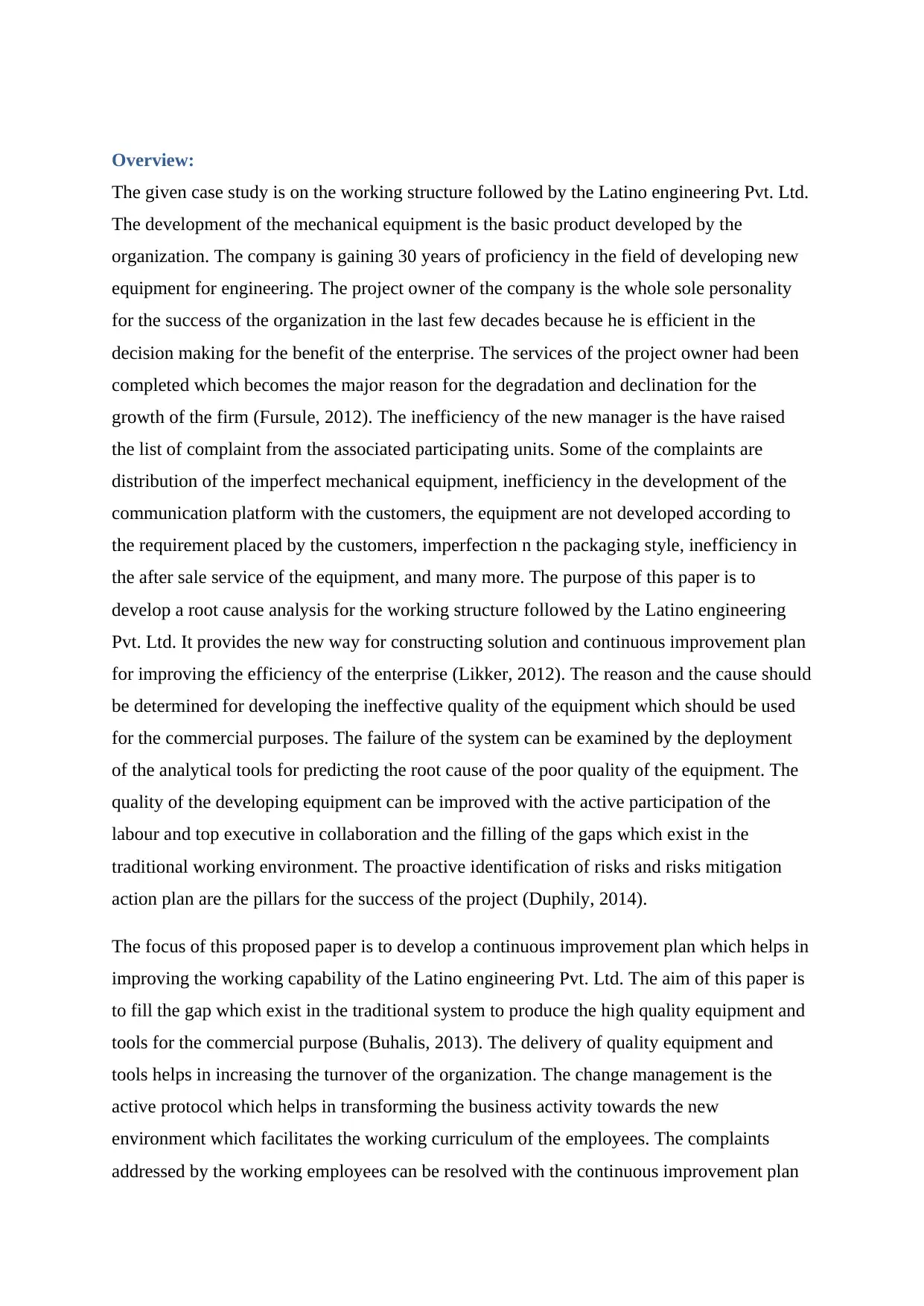
Overview:
The given case study is on the working structure followed by the Latino engineering Pvt. Ltd.
The development of the mechanical equipment is the basic product developed by the
organization. The company is gaining 30 years of proficiency in the field of developing new
equipment for engineering. The project owner of the company is the whole sole personality
for the success of the organization in the last few decades because he is efficient in the
decision making for the benefit of the enterprise. The services of the project owner had been
completed which becomes the major reason for the degradation and declination for the
growth of the firm (Fursule, 2012). The inefficiency of the new manager is the have raised
the list of complaint from the associated participating units. Some of the complaints are
distribution of the imperfect mechanical equipment, inefficiency in the development of the
communication platform with the customers, the equipment are not developed according to
the requirement placed by the customers, imperfection n the packaging style, inefficiency in
the after sale service of the equipment, and many more. The purpose of this paper is to
develop a root cause analysis for the working structure followed by the Latino engineering
Pvt. Ltd. It provides the new way for constructing solution and continuous improvement plan
for improving the efficiency of the enterprise (Likker, 2012). The reason and the cause should
be determined for developing the ineffective quality of the equipment which should be used
for the commercial purposes. The failure of the system can be examined by the deployment
of the analytical tools for predicting the root cause of the poor quality of the equipment. The
quality of the developing equipment can be improved with the active participation of the
labour and top executive in collaboration and the filling of the gaps which exist in the
traditional working environment. The proactive identification of risks and risks mitigation
action plan are the pillars for the success of the project (Duphily, 2014).
The focus of this proposed paper is to develop a continuous improvement plan which helps in
improving the working capability of the Latino engineering Pvt. Ltd. The aim of this paper is
to fill the gap which exist in the traditional system to produce the high quality equipment and
tools for the commercial purpose (Buhalis, 2013). The delivery of quality equipment and
tools helps in increasing the turnover of the organization. The change management is the
active protocol which helps in transforming the business activity towards the new
environment which facilitates the working curriculum of the employees. The complaints
addressed by the working employees can be resolved with the continuous improvement plan
The given case study is on the working structure followed by the Latino engineering Pvt. Ltd.
The development of the mechanical equipment is the basic product developed by the
organization. The company is gaining 30 years of proficiency in the field of developing new
equipment for engineering. The project owner of the company is the whole sole personality
for the success of the organization in the last few decades because he is efficient in the
decision making for the benefit of the enterprise. The services of the project owner had been
completed which becomes the major reason for the degradation and declination for the
growth of the firm (Fursule, 2012). The inefficiency of the new manager is the have raised
the list of complaint from the associated participating units. Some of the complaints are
distribution of the imperfect mechanical equipment, inefficiency in the development of the
communication platform with the customers, the equipment are not developed according to
the requirement placed by the customers, imperfection n the packaging style, inefficiency in
the after sale service of the equipment, and many more. The purpose of this paper is to
develop a root cause analysis for the working structure followed by the Latino engineering
Pvt. Ltd. It provides the new way for constructing solution and continuous improvement plan
for improving the efficiency of the enterprise (Likker, 2012). The reason and the cause should
be determined for developing the ineffective quality of the equipment which should be used
for the commercial purposes. The failure of the system can be examined by the deployment
of the analytical tools for predicting the root cause of the poor quality of the equipment. The
quality of the developing equipment can be improved with the active participation of the
labour and top executive in collaboration and the filling of the gaps which exist in the
traditional working environment. The proactive identification of risks and risks mitigation
action plan are the pillars for the success of the project (Duphily, 2014).
The focus of this proposed paper is to develop a continuous improvement plan which helps in
improving the working capability of the Latino engineering Pvt. Ltd. The aim of this paper is
to fill the gap which exist in the traditional system to produce the high quality equipment and
tools for the commercial purpose (Buhalis, 2013). The delivery of quality equipment and
tools helps in increasing the turnover of the organization. The change management is the
active protocol which helps in transforming the business activity towards the new
environment which facilitates the working curriculum of the employees. The complaints
addressed by the working employees can be resolved with the continuous improvement plan
⊘ This is a preview!⊘
Do you want full access?
Subscribe today to unlock all pages.

Trusted by 1+ million students worldwide
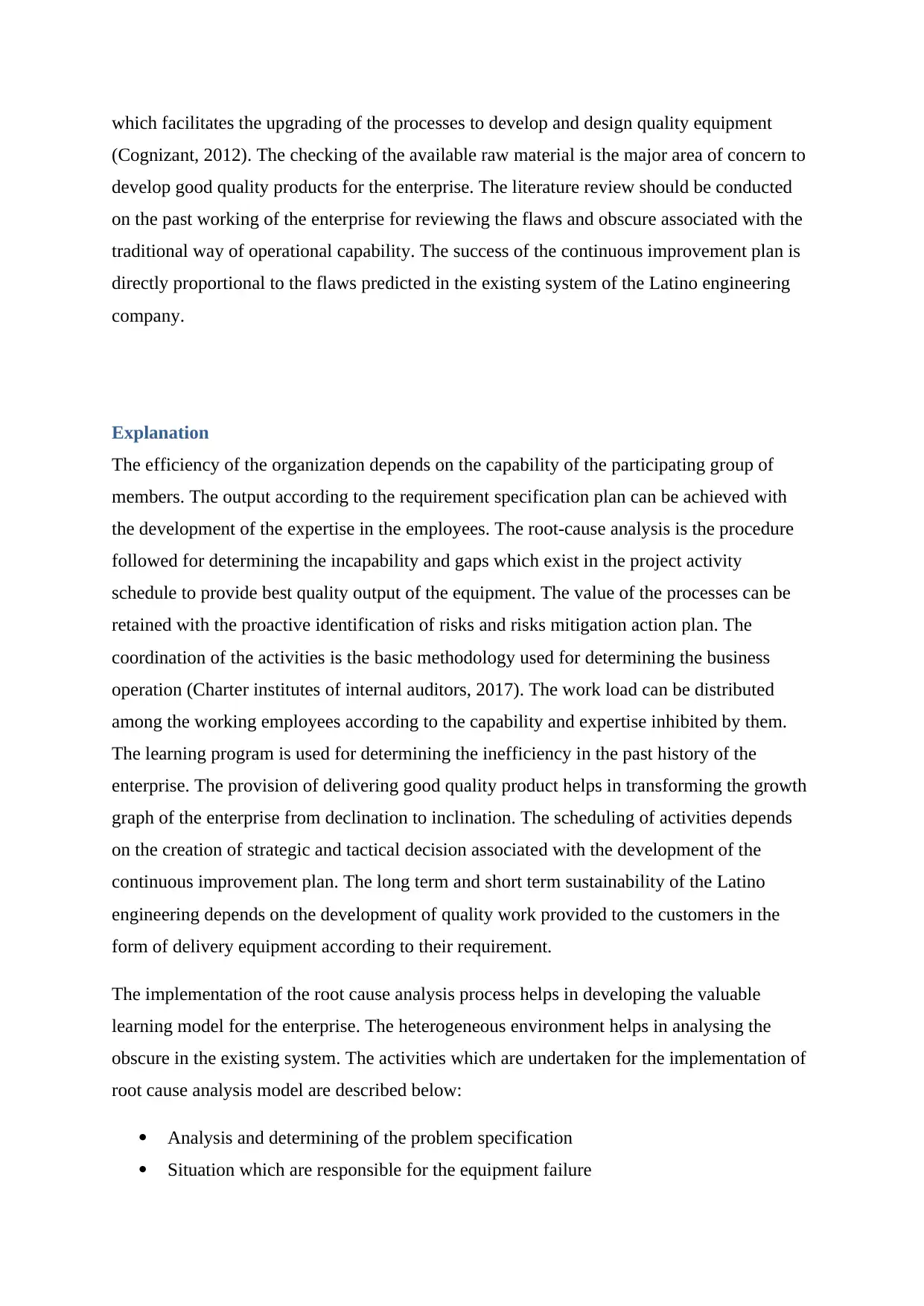
which facilitates the upgrading of the processes to develop and design quality equipment
(Cognizant, 2012). The checking of the available raw material is the major area of concern to
develop good quality products for the enterprise. The literature review should be conducted
on the past working of the enterprise for reviewing the flaws and obscure associated with the
traditional way of operational capability. The success of the continuous improvement plan is
directly proportional to the flaws predicted in the existing system of the Latino engineering
company.
Explanation
The efficiency of the organization depends on the capability of the participating group of
members. The output according to the requirement specification plan can be achieved with
the development of the expertise in the employees. The root-cause analysis is the procedure
followed for determining the incapability and gaps which exist in the project activity
schedule to provide best quality output of the equipment. The value of the processes can be
retained with the proactive identification of risks and risks mitigation action plan. The
coordination of the activities is the basic methodology used for determining the business
operation (Charter institutes of internal auditors, 2017). The work load can be distributed
among the working employees according to the capability and expertise inhibited by them.
The learning program is used for determining the inefficiency in the past history of the
enterprise. The provision of delivering good quality product helps in transforming the growth
graph of the enterprise from declination to inclination. The scheduling of activities depends
on the creation of strategic and tactical decision associated with the development of the
continuous improvement plan. The long term and short term sustainability of the Latino
engineering depends on the development of quality work provided to the customers in the
form of delivery equipment according to their requirement.
The implementation of the root cause analysis process helps in developing the valuable
learning model for the enterprise. The heterogeneous environment helps in analysing the
obscure in the existing system. The activities which are undertaken for the implementation of
root cause analysis model are described below:
Analysis and determining of the problem specification
Situation which are responsible for the equipment failure
(Cognizant, 2012). The checking of the available raw material is the major area of concern to
develop good quality products for the enterprise. The literature review should be conducted
on the past working of the enterprise for reviewing the flaws and obscure associated with the
traditional way of operational capability. The success of the continuous improvement plan is
directly proportional to the flaws predicted in the existing system of the Latino engineering
company.
Explanation
The efficiency of the organization depends on the capability of the participating group of
members. The output according to the requirement specification plan can be achieved with
the development of the expertise in the employees. The root-cause analysis is the procedure
followed for determining the incapability and gaps which exist in the project activity
schedule to provide best quality output of the equipment. The value of the processes can be
retained with the proactive identification of risks and risks mitigation action plan. The
coordination of the activities is the basic methodology used for determining the business
operation (Charter institutes of internal auditors, 2017). The work load can be distributed
among the working employees according to the capability and expertise inhibited by them.
The learning program is used for determining the inefficiency in the past history of the
enterprise. The provision of delivering good quality product helps in transforming the growth
graph of the enterprise from declination to inclination. The scheduling of activities depends
on the creation of strategic and tactical decision associated with the development of the
continuous improvement plan. The long term and short term sustainability of the Latino
engineering depends on the development of quality work provided to the customers in the
form of delivery equipment according to their requirement.
The implementation of the root cause analysis process helps in developing the valuable
learning model for the enterprise. The heterogeneous environment helps in analysing the
obscure in the existing system. The activities which are undertaken for the implementation of
root cause analysis model are described below:
Analysis and determining of the problem specification
Situation which are responsible for the equipment failure
Paraphrase This Document
Need a fresh take? Get an instant paraphrase of this document with our AI Paraphraser
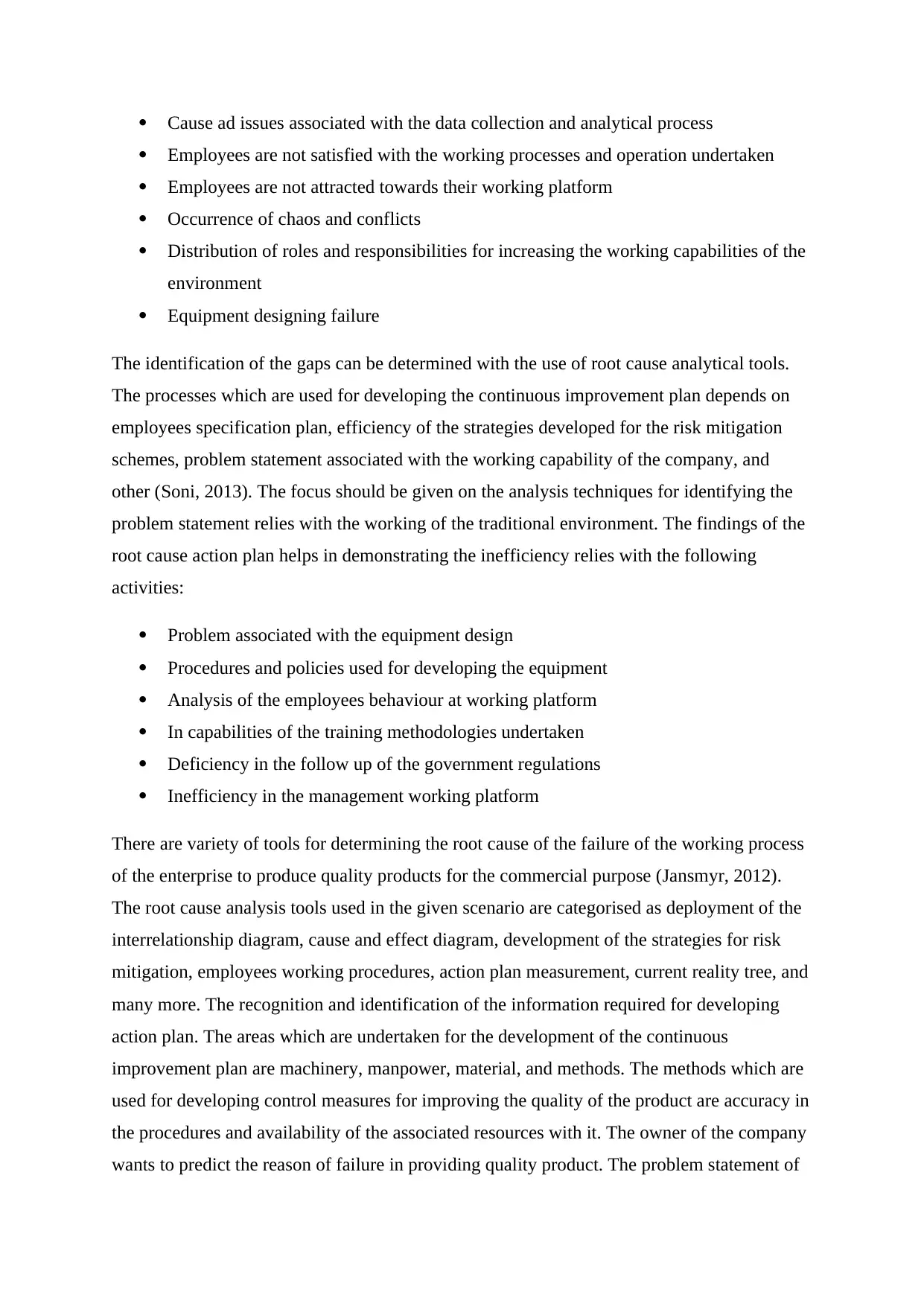
Cause ad issues associated with the data collection and analytical process
Employees are not satisfied with the working processes and operation undertaken
Employees are not attracted towards their working platform
Occurrence of chaos and conflicts
Distribution of roles and responsibilities for increasing the working capabilities of the
environment
Equipment designing failure
The identification of the gaps can be determined with the use of root cause analytical tools.
The processes which are used for developing the continuous improvement plan depends on
employees specification plan, efficiency of the strategies developed for the risk mitigation
schemes, problem statement associated with the working capability of the company, and
other (Soni, 2013). The focus should be given on the analysis techniques for identifying the
problem statement relies with the working of the traditional environment. The findings of the
root cause action plan helps in demonstrating the inefficiency relies with the following
activities:
Problem associated with the equipment design
Procedures and policies used for developing the equipment
Analysis of the employees behaviour at working platform
In capabilities of the training methodologies undertaken
Deficiency in the follow up of the government regulations
Inefficiency in the management working platform
There are variety of tools for determining the root cause of the failure of the working process
of the enterprise to produce quality products for the commercial purpose (Jansmyr, 2012).
The root cause analysis tools used in the given scenario are categorised as deployment of the
interrelationship diagram, cause and effect diagram, development of the strategies for risk
mitigation, employees working procedures, action plan measurement, current reality tree, and
many more. The recognition and identification of the information required for developing
action plan. The areas which are undertaken for the development of the continuous
improvement plan are machinery, manpower, material, and methods. The methods which are
used for developing control measures for improving the quality of the product are accuracy in
the procedures and availability of the associated resources with it. The owner of the company
wants to predict the reason of failure in providing quality product. The problem statement of
Employees are not satisfied with the working processes and operation undertaken
Employees are not attracted towards their working platform
Occurrence of chaos and conflicts
Distribution of roles and responsibilities for increasing the working capabilities of the
environment
Equipment designing failure
The identification of the gaps can be determined with the use of root cause analytical tools.
The processes which are used for developing the continuous improvement plan depends on
employees specification plan, efficiency of the strategies developed for the risk mitigation
schemes, problem statement associated with the working capability of the company, and
other (Soni, 2013). The focus should be given on the analysis techniques for identifying the
problem statement relies with the working of the traditional environment. The findings of the
root cause action plan helps in demonstrating the inefficiency relies with the following
activities:
Problem associated with the equipment design
Procedures and policies used for developing the equipment
Analysis of the employees behaviour at working platform
In capabilities of the training methodologies undertaken
Deficiency in the follow up of the government regulations
Inefficiency in the management working platform
There are variety of tools for determining the root cause of the failure of the working process
of the enterprise to produce quality products for the commercial purpose (Jansmyr, 2012).
The root cause analysis tools used in the given scenario are categorised as deployment of the
interrelationship diagram, cause and effect diagram, development of the strategies for risk
mitigation, employees working procedures, action plan measurement, current reality tree, and
many more. The recognition and identification of the information required for developing
action plan. The areas which are undertaken for the development of the continuous
improvement plan are machinery, manpower, material, and methods. The methods which are
used for developing control measures for improving the quality of the product are accuracy in
the procedures and availability of the associated resources with it. The owner of the company
wants to predict the reason of failure in providing quality product. The problem statement of
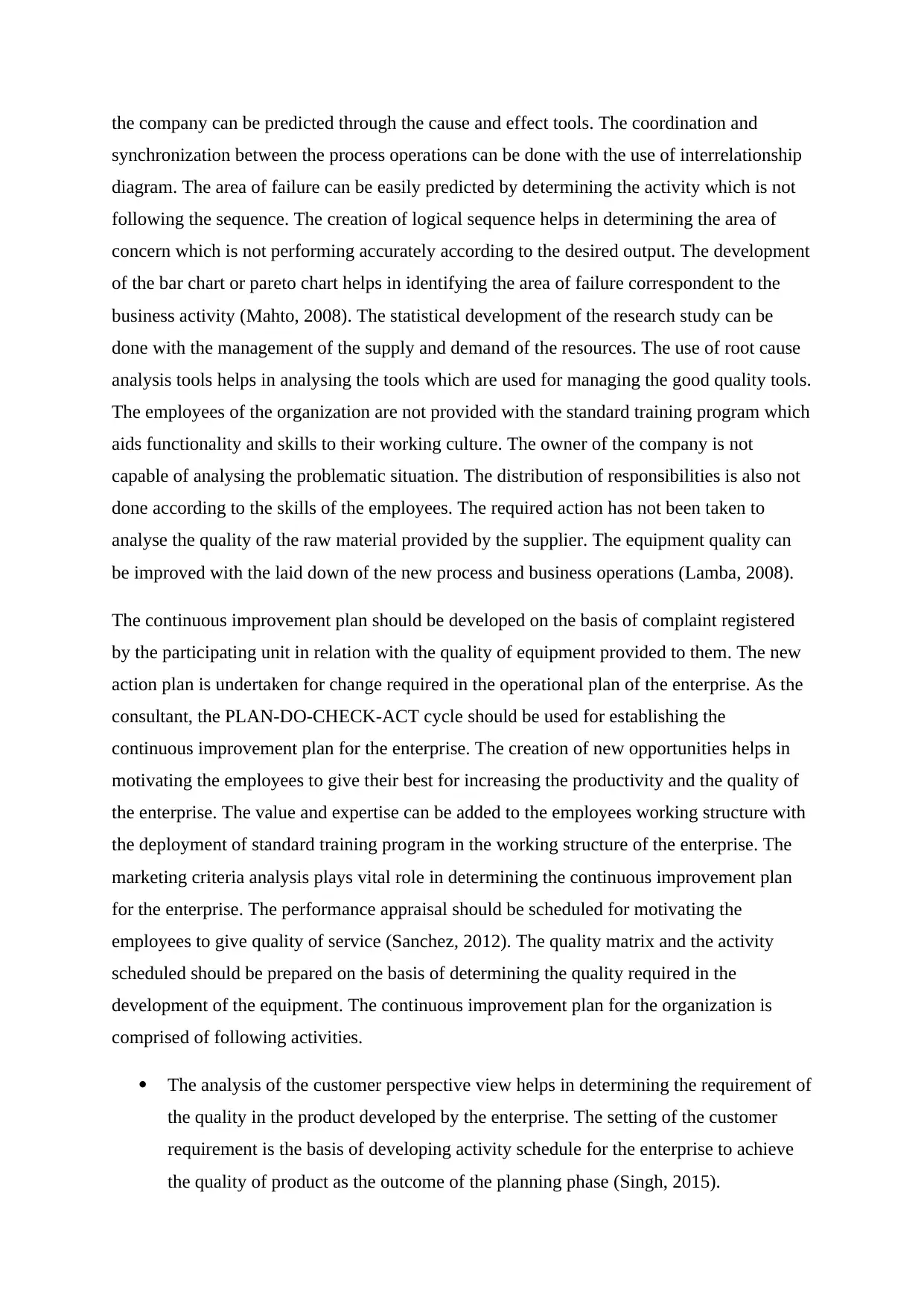
the company can be predicted through the cause and effect tools. The coordination and
synchronization between the process operations can be done with the use of interrelationship
diagram. The area of failure can be easily predicted by determining the activity which is not
following the sequence. The creation of logical sequence helps in determining the area of
concern which is not performing accurately according to the desired output. The development
of the bar chart or pareto chart helps in identifying the area of failure correspondent to the
business activity (Mahto, 2008). The statistical development of the research study can be
done with the management of the supply and demand of the resources. The use of root cause
analysis tools helps in analysing the tools which are used for managing the good quality tools.
The employees of the organization are not provided with the standard training program which
aids functionality and skills to their working culture. The owner of the company is not
capable of analysing the problematic situation. The distribution of responsibilities is also not
done according to the skills of the employees. The required action has not been taken to
analyse the quality of the raw material provided by the supplier. The equipment quality can
be improved with the laid down of the new process and business operations (Lamba, 2008).
The continuous improvement plan should be developed on the basis of complaint registered
by the participating unit in relation with the quality of equipment provided to them. The new
action plan is undertaken for change required in the operational plan of the enterprise. As the
consultant, the PLAN-DO-CHECK-ACT cycle should be used for establishing the
continuous improvement plan for the enterprise. The creation of new opportunities helps in
motivating the employees to give their best for increasing the productivity and the quality of
the enterprise. The value and expertise can be added to the employees working structure with
the deployment of standard training program in the working structure of the enterprise. The
marketing criteria analysis plays vital role in determining the continuous improvement plan
for the enterprise. The performance appraisal should be scheduled for motivating the
employees to give quality of service (Sanchez, 2012). The quality matrix and the activity
scheduled should be prepared on the basis of determining the quality required in the
development of the equipment. The continuous improvement plan for the organization is
comprised of following activities.
The analysis of the customer perspective view helps in determining the requirement of
the quality in the product developed by the enterprise. The setting of the customer
requirement is the basis of developing activity schedule for the enterprise to achieve
the quality of product as the outcome of the planning phase (Singh, 2015).
synchronization between the process operations can be done with the use of interrelationship
diagram. The area of failure can be easily predicted by determining the activity which is not
following the sequence. The creation of logical sequence helps in determining the area of
concern which is not performing accurately according to the desired output. The development
of the bar chart or pareto chart helps in identifying the area of failure correspondent to the
business activity (Mahto, 2008). The statistical development of the research study can be
done with the management of the supply and demand of the resources. The use of root cause
analysis tools helps in analysing the tools which are used for managing the good quality tools.
The employees of the organization are not provided with the standard training program which
aids functionality and skills to their working culture. The owner of the company is not
capable of analysing the problematic situation. The distribution of responsibilities is also not
done according to the skills of the employees. The required action has not been taken to
analyse the quality of the raw material provided by the supplier. The equipment quality can
be improved with the laid down of the new process and business operations (Lamba, 2008).
The continuous improvement plan should be developed on the basis of complaint registered
by the participating unit in relation with the quality of equipment provided to them. The new
action plan is undertaken for change required in the operational plan of the enterprise. As the
consultant, the PLAN-DO-CHECK-ACT cycle should be used for establishing the
continuous improvement plan for the enterprise. The creation of new opportunities helps in
motivating the employees to give their best for increasing the productivity and the quality of
the enterprise. The value and expertise can be added to the employees working structure with
the deployment of standard training program in the working structure of the enterprise. The
marketing criteria analysis plays vital role in determining the continuous improvement plan
for the enterprise. The performance appraisal should be scheduled for motivating the
employees to give quality of service (Sanchez, 2012). The quality matrix and the activity
scheduled should be prepared on the basis of determining the quality required in the
development of the equipment. The continuous improvement plan for the organization is
comprised of following activities.
The analysis of the customer perspective view helps in determining the requirement of
the quality in the product developed by the enterprise. The setting of the customer
requirement is the basis of developing activity schedule for the enterprise to achieve
the quality of product as the outcome of the planning phase (Singh, 2015).
⊘ This is a preview!⊘
Do you want full access?
Subscribe today to unlock all pages.

Trusted by 1+ million students worldwide
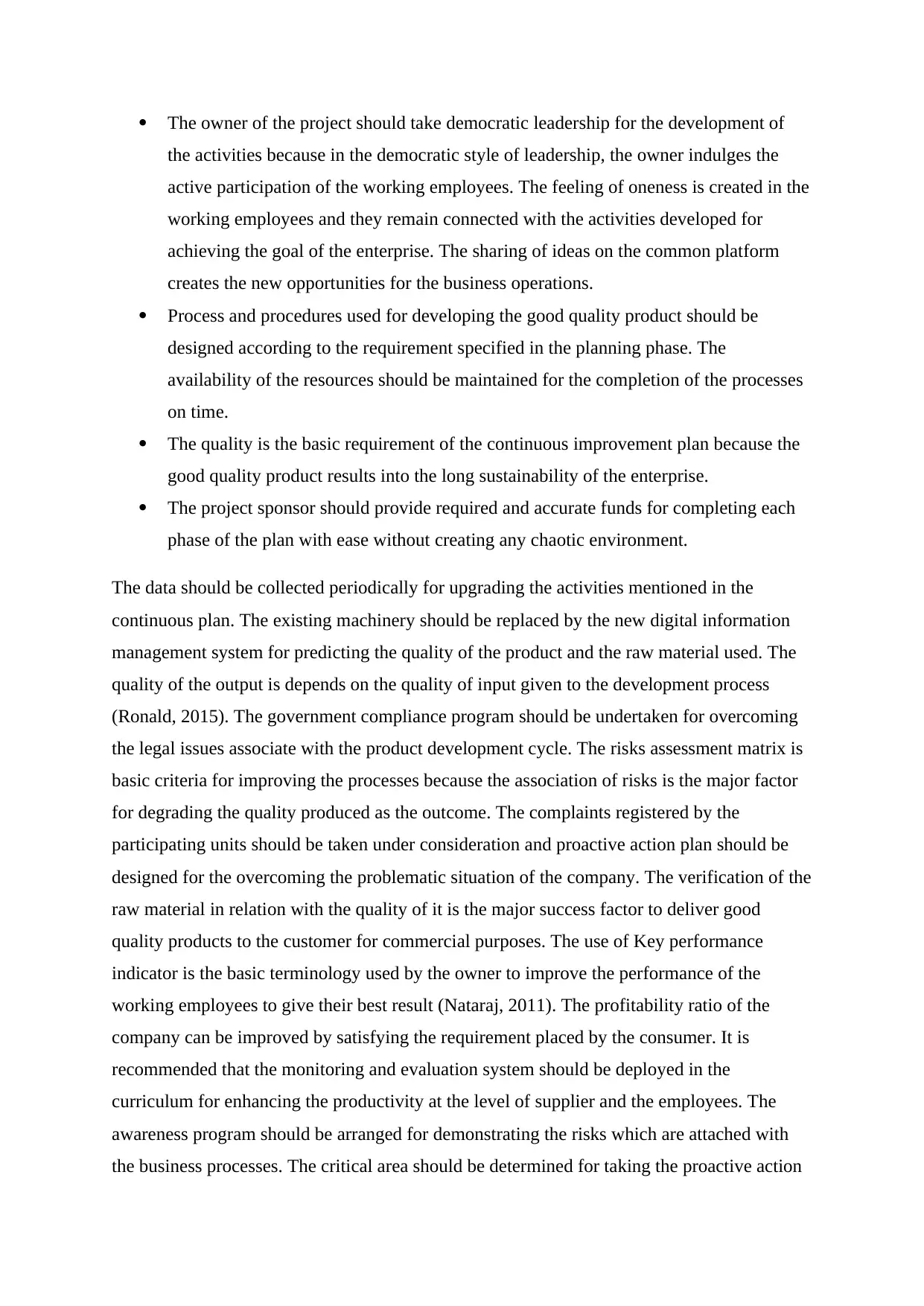
The owner of the project should take democratic leadership for the development of
the activities because in the democratic style of leadership, the owner indulges the
active participation of the working employees. The feeling of oneness is created in the
working employees and they remain connected with the activities developed for
achieving the goal of the enterprise. The sharing of ideas on the common platform
creates the new opportunities for the business operations.
Process and procedures used for developing the good quality product should be
designed according to the requirement specified in the planning phase. The
availability of the resources should be maintained for the completion of the processes
on time.
The quality is the basic requirement of the continuous improvement plan because the
good quality product results into the long sustainability of the enterprise.
The project sponsor should provide required and accurate funds for completing each
phase of the plan with ease without creating any chaotic environment.
The data should be collected periodically for upgrading the activities mentioned in the
continuous plan. The existing machinery should be replaced by the new digital information
management system for predicting the quality of the product and the raw material used. The
quality of the output is depends on the quality of input given to the development process
(Ronald, 2015). The government compliance program should be undertaken for overcoming
the legal issues associate with the product development cycle. The risks assessment matrix is
basic criteria for improving the processes because the association of risks is the major factor
for degrading the quality produced as the outcome. The complaints registered by the
participating units should be taken under consideration and proactive action plan should be
designed for the overcoming the problematic situation of the company. The verification of the
raw material in relation with the quality of it is the major success factor to deliver good
quality products to the customer for commercial purposes. The use of Key performance
indicator is the basic terminology used by the owner to improve the performance of the
working employees to give their best result (Nataraj, 2011). The profitability ratio of the
company can be improved by satisfying the requirement placed by the consumer. It is
recommended that the monitoring and evaluation system should be deployed in the
curriculum for enhancing the productivity at the level of supplier and the employees. The
awareness program should be arranged for demonstrating the risks which are attached with
the business processes. The critical area should be determined for taking the proactive action
the activities because in the democratic style of leadership, the owner indulges the
active participation of the working employees. The feeling of oneness is created in the
working employees and they remain connected with the activities developed for
achieving the goal of the enterprise. The sharing of ideas on the common platform
creates the new opportunities for the business operations.
Process and procedures used for developing the good quality product should be
designed according to the requirement specified in the planning phase. The
availability of the resources should be maintained for the completion of the processes
on time.
The quality is the basic requirement of the continuous improvement plan because the
good quality product results into the long sustainability of the enterprise.
The project sponsor should provide required and accurate funds for completing each
phase of the plan with ease without creating any chaotic environment.
The data should be collected periodically for upgrading the activities mentioned in the
continuous plan. The existing machinery should be replaced by the new digital information
management system for predicting the quality of the product and the raw material used. The
quality of the output is depends on the quality of input given to the development process
(Ronald, 2015). The government compliance program should be undertaken for overcoming
the legal issues associate with the product development cycle. The risks assessment matrix is
basic criteria for improving the processes because the association of risks is the major factor
for degrading the quality produced as the outcome. The complaints registered by the
participating units should be taken under consideration and proactive action plan should be
designed for the overcoming the problematic situation of the company. The verification of the
raw material in relation with the quality of it is the major success factor to deliver good
quality products to the customer for commercial purposes. The use of Key performance
indicator is the basic terminology used by the owner to improve the performance of the
working employees to give their best result (Nataraj, 2011). The profitability ratio of the
company can be improved by satisfying the requirement placed by the consumer. It is
recommended that the monitoring and evaluation system should be deployed in the
curriculum for enhancing the productivity at the level of supplier and the employees. The
awareness program should be arranged for demonstrating the risks which are attached with
the business processes. The critical area should be determined for taking the proactive action
Paraphrase This Document
Need a fresh take? Get an instant paraphrase of this document with our AI Paraphraser
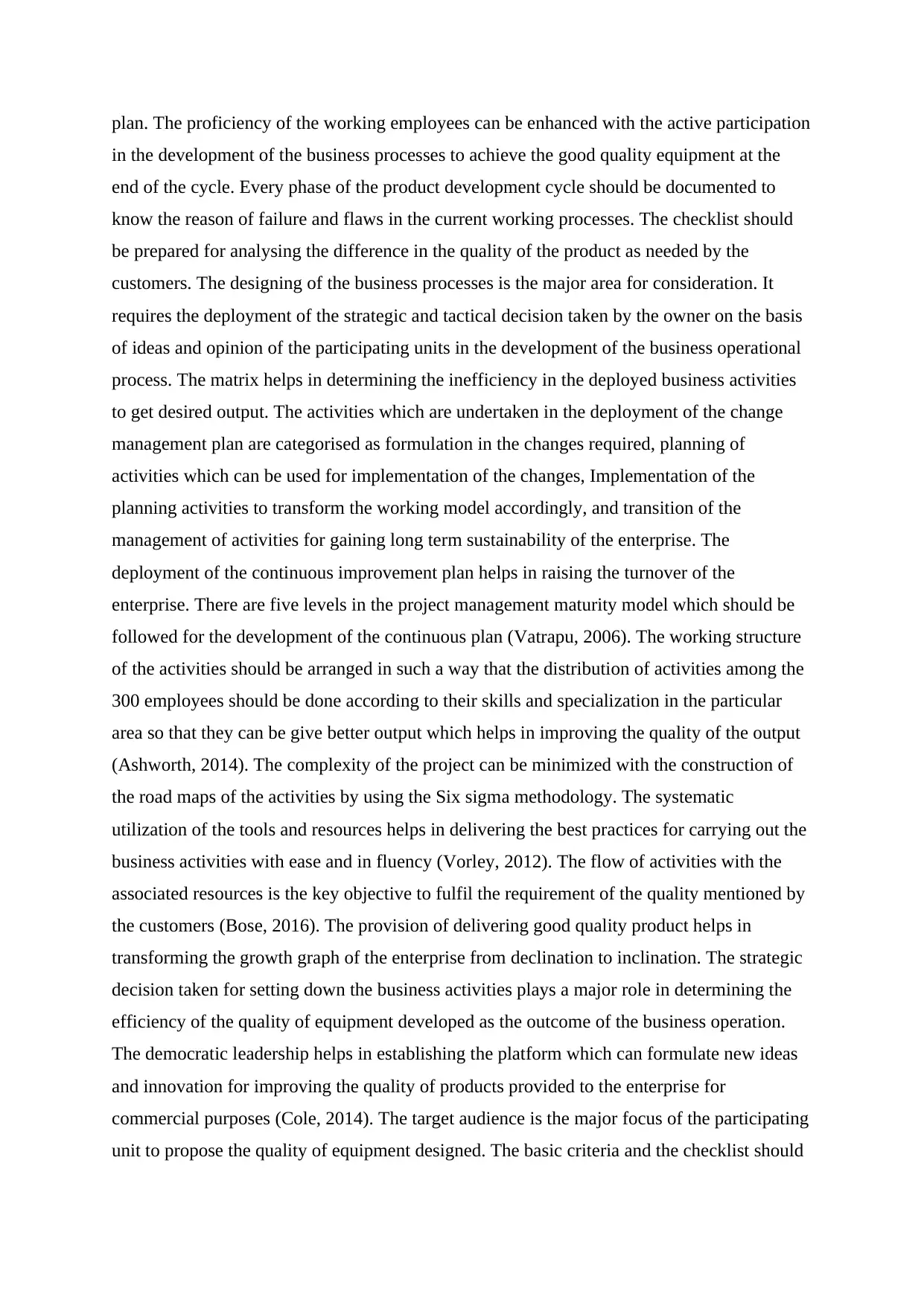
plan. The proficiency of the working employees can be enhanced with the active participation
in the development of the business processes to achieve the good quality equipment at the
end of the cycle. Every phase of the product development cycle should be documented to
know the reason of failure and flaws in the current working processes. The checklist should
be prepared for analysing the difference in the quality of the product as needed by the
customers. The designing of the business processes is the major area for consideration. It
requires the deployment of the strategic and tactical decision taken by the owner on the basis
of ideas and opinion of the participating units in the development of the business operational
process. The matrix helps in determining the inefficiency in the deployed business activities
to get desired output. The activities which are undertaken in the deployment of the change
management plan are categorised as formulation in the changes required, planning of
activities which can be used for implementation of the changes, Implementation of the
planning activities to transform the working model accordingly, and transition of the
management of activities for gaining long term sustainability of the enterprise. The
deployment of the continuous improvement plan helps in raising the turnover of the
enterprise. There are five levels in the project management maturity model which should be
followed for the development of the continuous plan (Vatrapu, 2006). The working structure
of the activities should be arranged in such a way that the distribution of activities among the
300 employees should be done according to their skills and specialization in the particular
area so that they can be give better output which helps in improving the quality of the output
(Ashworth, 2014). The complexity of the project can be minimized with the construction of
the road maps of the activities by using the Six sigma methodology. The systematic
utilization of the tools and resources helps in delivering the best practices for carrying out the
business activities with ease and in fluency (Vorley, 2012). The flow of activities with the
associated resources is the key objective to fulfil the requirement of the quality mentioned by
the customers (Bose, 2016). The provision of delivering good quality product helps in
transforming the growth graph of the enterprise from declination to inclination. The strategic
decision taken for setting down the business activities plays a major role in determining the
efficiency of the quality of equipment developed as the outcome of the business operation.
The democratic leadership helps in establishing the platform which can formulate new ideas
and innovation for improving the quality of products provided to the enterprise for
commercial purposes (Cole, 2014). The target audience is the major focus of the participating
unit to propose the quality of equipment designed. The basic criteria and the checklist should
in the development of the business processes to achieve the good quality equipment at the
end of the cycle. Every phase of the product development cycle should be documented to
know the reason of failure and flaws in the current working processes. The checklist should
be prepared for analysing the difference in the quality of the product as needed by the
customers. The designing of the business processes is the major area for consideration. It
requires the deployment of the strategic and tactical decision taken by the owner on the basis
of ideas and opinion of the participating units in the development of the business operational
process. The matrix helps in determining the inefficiency in the deployed business activities
to get desired output. The activities which are undertaken in the deployment of the change
management plan are categorised as formulation in the changes required, planning of
activities which can be used for implementation of the changes, Implementation of the
planning activities to transform the working model accordingly, and transition of the
management of activities for gaining long term sustainability of the enterprise. The
deployment of the continuous improvement plan helps in raising the turnover of the
enterprise. There are five levels in the project management maturity model which should be
followed for the development of the continuous plan (Vatrapu, 2006). The working structure
of the activities should be arranged in such a way that the distribution of activities among the
300 employees should be done according to their skills and specialization in the particular
area so that they can be give better output which helps in improving the quality of the output
(Ashworth, 2014). The complexity of the project can be minimized with the construction of
the road maps of the activities by using the Six sigma methodology. The systematic
utilization of the tools and resources helps in delivering the best practices for carrying out the
business activities with ease and in fluency (Vorley, 2012). The flow of activities with the
associated resources is the key objective to fulfil the requirement of the quality mentioned by
the customers (Bose, 2016). The provision of delivering good quality product helps in
transforming the growth graph of the enterprise from declination to inclination. The strategic
decision taken for setting down the business activities plays a major role in determining the
efficiency of the quality of equipment developed as the outcome of the business operation.
The democratic leadership helps in establishing the platform which can formulate new ideas
and innovation for improving the quality of products provided to the enterprise for
commercial purposes (Cole, 2014). The target audience is the major focus of the participating
unit to propose the quality of equipment designed. The basic criteria and the checklist should
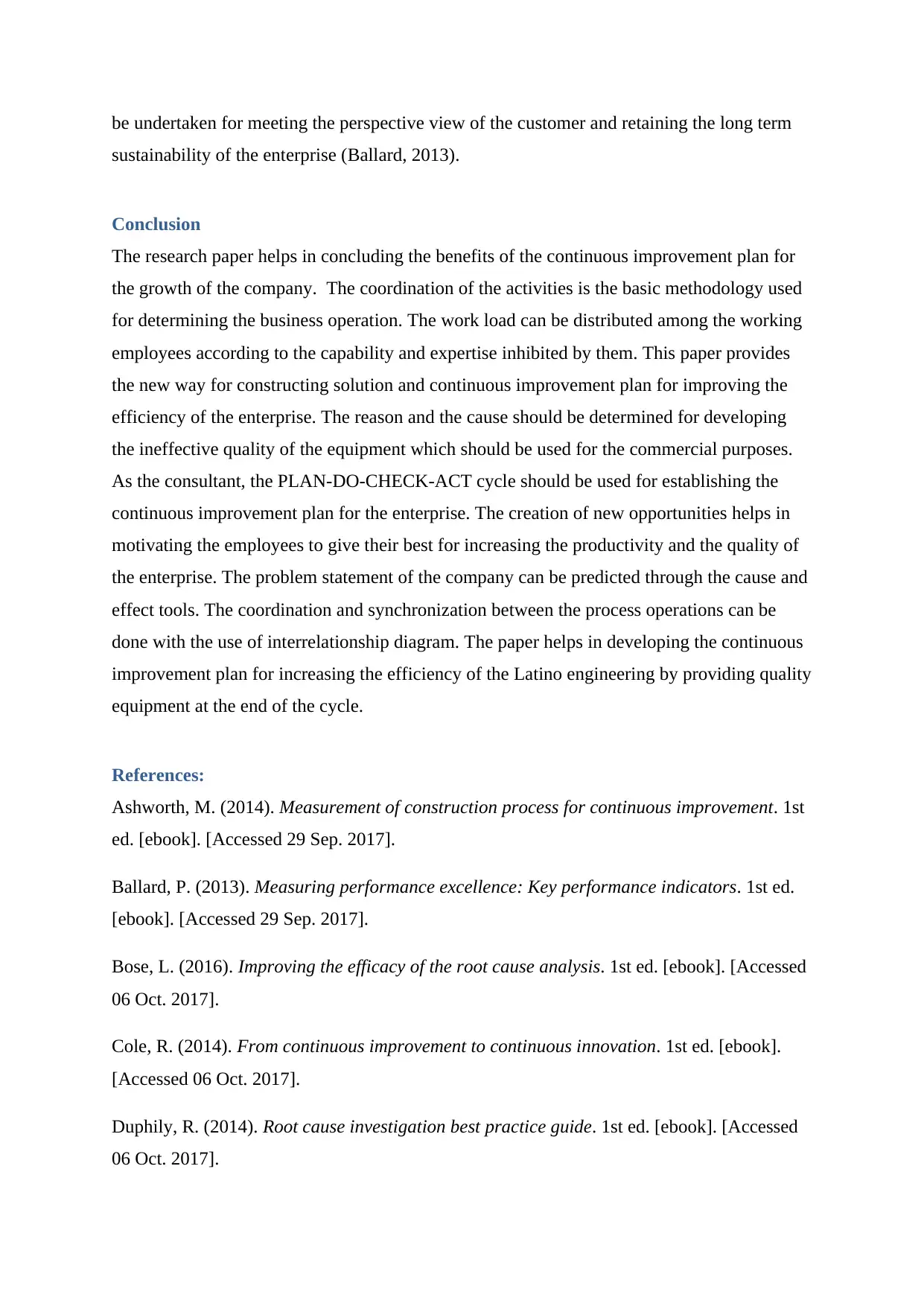
be undertaken for meeting the perspective view of the customer and retaining the long term
sustainability of the enterprise (Ballard, 2013).
Conclusion
The research paper helps in concluding the benefits of the continuous improvement plan for
the growth of the company. The coordination of the activities is the basic methodology used
for determining the business operation. The work load can be distributed among the working
employees according to the capability and expertise inhibited by them. This paper provides
the new way for constructing solution and continuous improvement plan for improving the
efficiency of the enterprise. The reason and the cause should be determined for developing
the ineffective quality of the equipment which should be used for the commercial purposes.
As the consultant, the PLAN-DO-CHECK-ACT cycle should be used for establishing the
continuous improvement plan for the enterprise. The creation of new opportunities helps in
motivating the employees to give their best for increasing the productivity and the quality of
the enterprise. The problem statement of the company can be predicted through the cause and
effect tools. The coordination and synchronization between the process operations can be
done with the use of interrelationship diagram. The paper helps in developing the continuous
improvement plan for increasing the efficiency of the Latino engineering by providing quality
equipment at the end of the cycle.
References:
Ashworth, M. (2014). Measurement of construction process for continuous improvement. 1st
ed. [ebook]. [Accessed 29 Sep. 2017].
Ballard, P. (2013). Measuring performance excellence: Key performance indicators. 1st ed.
[ebook]. [Accessed 29 Sep. 2017].
Bose, L. (2016). Improving the efficacy of the root cause analysis. 1st ed. [ebook]. [Accessed
06 Oct. 2017].
Cole, R. (2014). From continuous improvement to continuous innovation. 1st ed. [ebook].
[Accessed 06 Oct. 2017].
Duphily, R. (2014). Root cause investigation best practice guide. 1st ed. [ebook]. [Accessed
06 Oct. 2017].
sustainability of the enterprise (Ballard, 2013).
Conclusion
The research paper helps in concluding the benefits of the continuous improvement plan for
the growth of the company. The coordination of the activities is the basic methodology used
for determining the business operation. The work load can be distributed among the working
employees according to the capability and expertise inhibited by them. This paper provides
the new way for constructing solution and continuous improvement plan for improving the
efficiency of the enterprise. The reason and the cause should be determined for developing
the ineffective quality of the equipment which should be used for the commercial purposes.
As the consultant, the PLAN-DO-CHECK-ACT cycle should be used for establishing the
continuous improvement plan for the enterprise. The creation of new opportunities helps in
motivating the employees to give their best for increasing the productivity and the quality of
the enterprise. The problem statement of the company can be predicted through the cause and
effect tools. The coordination and synchronization between the process operations can be
done with the use of interrelationship diagram. The paper helps in developing the continuous
improvement plan for increasing the efficiency of the Latino engineering by providing quality
equipment at the end of the cycle.
References:
Ashworth, M. (2014). Measurement of construction process for continuous improvement. 1st
ed. [ebook]. [Accessed 29 Sep. 2017].
Ballard, P. (2013). Measuring performance excellence: Key performance indicators. 1st ed.
[ebook]. [Accessed 29 Sep. 2017].
Bose, L. (2016). Improving the efficacy of the root cause analysis. 1st ed. [ebook]. [Accessed
06 Oct. 2017].
Cole, R. (2014). From continuous improvement to continuous innovation. 1st ed. [ebook].
[Accessed 06 Oct. 2017].
Duphily, R. (2014). Root cause investigation best practice guide. 1st ed. [ebook]. [Accessed
06 Oct. 2017].
⊘ This is a preview!⊘
Do you want full access?
Subscribe today to unlock all pages.

Trusted by 1+ million students worldwide
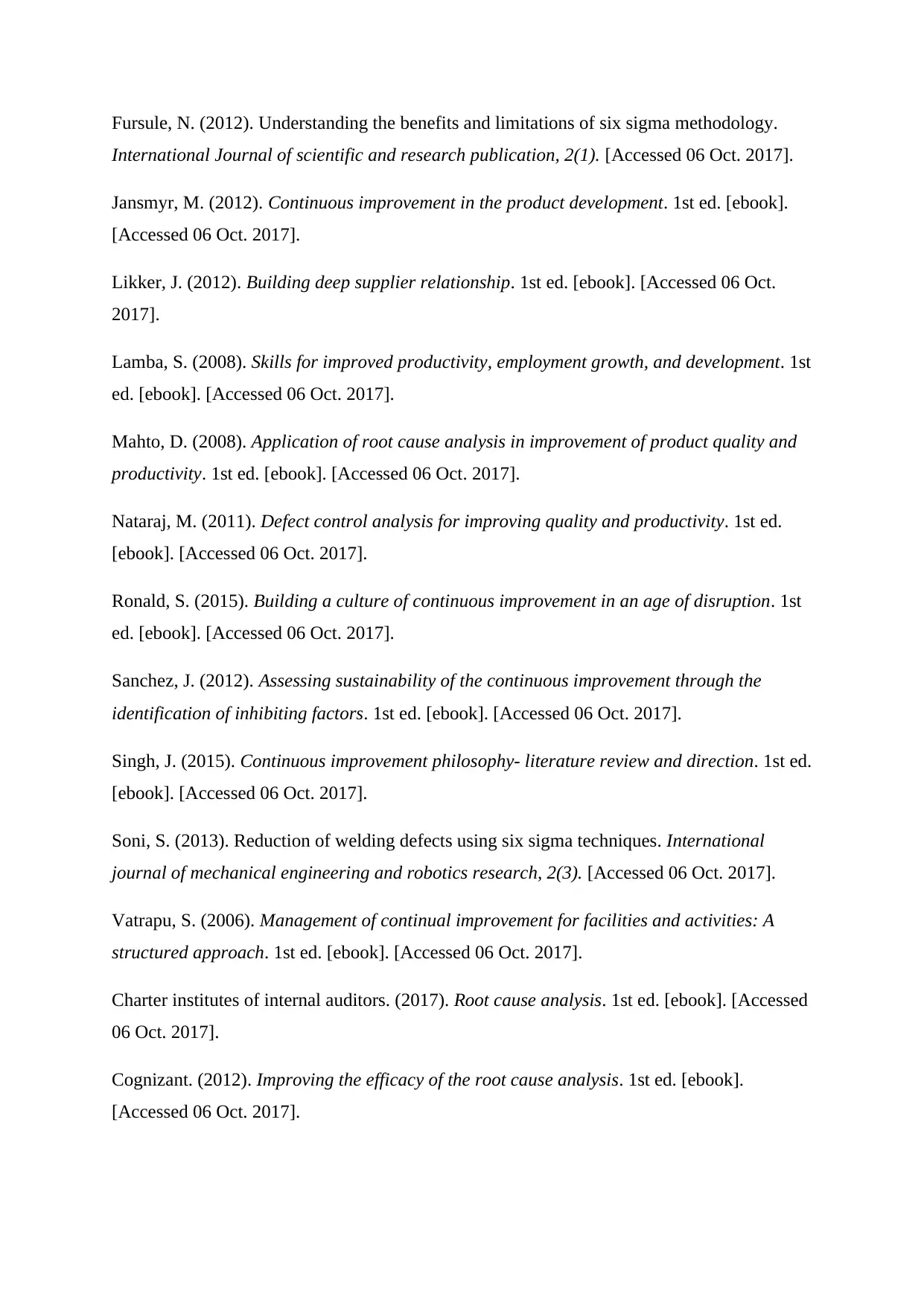
Fursule, N. (2012). Understanding the benefits and limitations of six sigma methodology.
International Journal of scientific and research publication, 2(1). [Accessed 06 Oct. 2017].
Jansmyr, M. (2012). Continuous improvement in the product development. 1st ed. [ebook].
[Accessed 06 Oct. 2017].
Likker, J. (2012). Building deep supplier relationship. 1st ed. [ebook]. [Accessed 06 Oct.
2017].
Lamba, S. (2008). Skills for improved productivity, employment growth, and development. 1st
ed. [ebook]. [Accessed 06 Oct. 2017].
Mahto, D. (2008). Application of root cause analysis in improvement of product quality and
productivity. 1st ed. [ebook]. [Accessed 06 Oct. 2017].
Nataraj, M. (2011). Defect control analysis for improving quality and productivity. 1st ed.
[ebook]. [Accessed 06 Oct. 2017].
Ronald, S. (2015). Building a culture of continuous improvement in an age of disruption. 1st
ed. [ebook]. [Accessed 06 Oct. 2017].
Sanchez, J. (2012). Assessing sustainability of the continuous improvement through the
identification of inhibiting factors. 1st ed. [ebook]. [Accessed 06 Oct. 2017].
Singh, J. (2015). Continuous improvement philosophy- literature review and direction. 1st ed.
[ebook]. [Accessed 06 Oct. 2017].
Soni, S. (2013). Reduction of welding defects using six sigma techniques. International
journal of mechanical engineering and robotics research, 2(3). [Accessed 06 Oct. 2017].
Vatrapu, S. (2006). Management of continual improvement for facilities and activities: A
structured approach. 1st ed. [ebook]. [Accessed 06 Oct. 2017].
Charter institutes of internal auditors. (2017). Root cause analysis. 1st ed. [ebook]. [Accessed
06 Oct. 2017].
Cognizant. (2012). Improving the efficacy of the root cause analysis. 1st ed. [ebook].
[Accessed 06 Oct. 2017].
International Journal of scientific and research publication, 2(1). [Accessed 06 Oct. 2017].
Jansmyr, M. (2012). Continuous improvement in the product development. 1st ed. [ebook].
[Accessed 06 Oct. 2017].
Likker, J. (2012). Building deep supplier relationship. 1st ed. [ebook]. [Accessed 06 Oct.
2017].
Lamba, S. (2008). Skills for improved productivity, employment growth, and development. 1st
ed. [ebook]. [Accessed 06 Oct. 2017].
Mahto, D. (2008). Application of root cause analysis in improvement of product quality and
productivity. 1st ed. [ebook]. [Accessed 06 Oct. 2017].
Nataraj, M. (2011). Defect control analysis for improving quality and productivity. 1st ed.
[ebook]. [Accessed 06 Oct. 2017].
Ronald, S. (2015). Building a culture of continuous improvement in an age of disruption. 1st
ed. [ebook]. [Accessed 06 Oct. 2017].
Sanchez, J. (2012). Assessing sustainability of the continuous improvement through the
identification of inhibiting factors. 1st ed. [ebook]. [Accessed 06 Oct. 2017].
Singh, J. (2015). Continuous improvement philosophy- literature review and direction. 1st ed.
[ebook]. [Accessed 06 Oct. 2017].
Soni, S. (2013). Reduction of welding defects using six sigma techniques. International
journal of mechanical engineering and robotics research, 2(3). [Accessed 06 Oct. 2017].
Vatrapu, S. (2006). Management of continual improvement for facilities and activities: A
structured approach. 1st ed. [ebook]. [Accessed 06 Oct. 2017].
Charter institutes of internal auditors. (2017). Root cause analysis. 1st ed. [ebook]. [Accessed
06 Oct. 2017].
Cognizant. (2012). Improving the efficacy of the root cause analysis. 1st ed. [ebook].
[Accessed 06 Oct. 2017].
Paraphrase This Document
Need a fresh take? Get an instant paraphrase of this document with our AI Paraphraser

Buhalis, S. (2013). An overview of the root cause analysis. 1st ed. [ebook]. [Accessed 06 Oct.
2017].
Vorley, G. (2012). Mini guide to root cause analysis. 1st ed. [ebook]. [Accessed 06 Oct.
2017].
Appendix
Development of the
safeguard plan
Reviewing of timeline
Monitoring of the plan
Continuation of the
risks identification
for action needed
Development of the
strategic plan for
continuous work flow
Evaluation of
the final
outcome
Development of
the continuous
improvement plan
Duty continues Development of the review
plan
Development of the
quality equipment
according to the
requirement
specification
Necessary action
taken for
evaluation
Assessment of the
action plan
Evaluation of the
quality for checking
the checklist
according to the
requirement
specification
2017].
Vorley, G. (2012). Mini guide to root cause analysis. 1st ed. [ebook]. [Accessed 06 Oct.
2017].
Appendix
Development of the
safeguard plan
Reviewing of timeline
Monitoring of the plan
Continuation of the
risks identification
for action needed
Development of the
strategic plan for
continuous work flow
Evaluation of
the final
outcome
Development of
the continuous
improvement plan
Duty continues Development of the review
plan
Development of the
quality equipment
according to the
requirement
specification
Necessary action
taken for
evaluation
Assessment of the
action plan
Evaluation of the
quality for checking
the checklist
according to the
requirement
specification
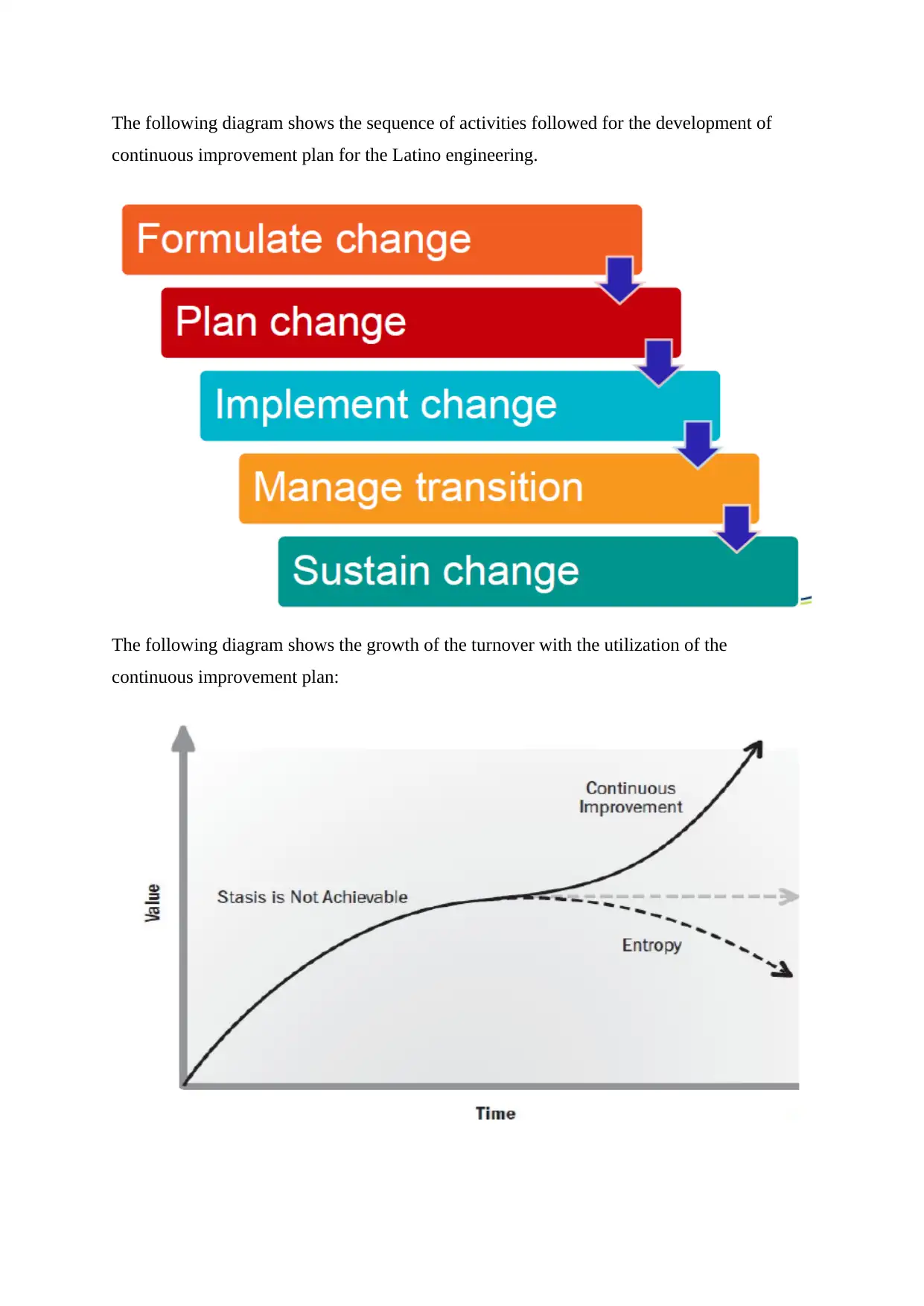
The following diagram shows the sequence of activities followed for the development of
continuous improvement plan for the Latino engineering.
The following diagram shows the growth of the turnover with the utilization of the
continuous improvement plan:
continuous improvement plan for the Latino engineering.
The following diagram shows the growth of the turnover with the utilization of the
continuous improvement plan:
⊘ This is a preview!⊘
Do you want full access?
Subscribe today to unlock all pages.

Trusted by 1+ million students worldwide
1 out of 12
Related Documents
Your All-in-One AI-Powered Toolkit for Academic Success.
+13062052269
info@desklib.com
Available 24*7 on WhatsApp / Email
![[object Object]](/_next/static/media/star-bottom.7253800d.svg)
Unlock your academic potential
Copyright © 2020–2025 A2Z Services. All Rights Reserved. Developed and managed by ZUCOL.





